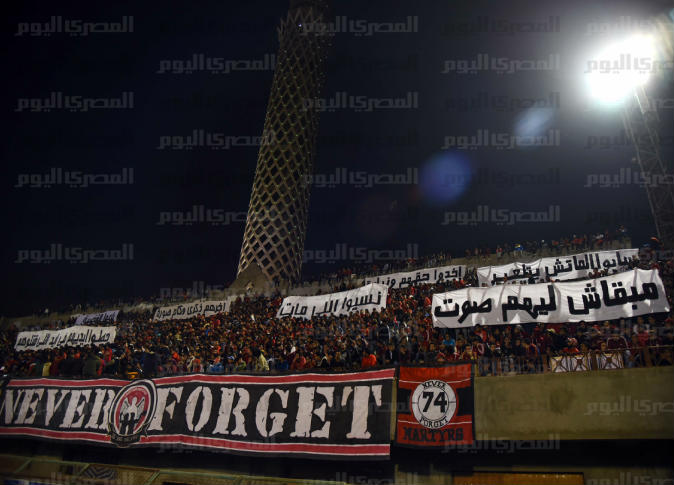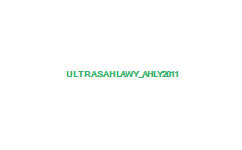
“An Ultras member works in the dark to provide light for the rest of his group. He does not care about himself or his career because all what he cares for is his club. He is the epitome of manliness and cooperation. The Ultras are not a group of savages and barbarians. They give meaning to patriotism and sacrifice without waiting for award.”
This was part of a lengthy introduction by Mohamed Gamal Bashir, author of the book “The Ultras” that was published in 2011, in which he says that what the Ultras do is not merely cheering for 90 minutes, but rather a creation of an overwhelming feeling that brings everyone together.
There has been considerable controversy about the Ultras from the beginning of their appearance to the final court ruling that has banned their activities.
The beginning
Bashir says that cheering in stadiums was sporadic and unorganized until the late 1980s when certain fans spontaneously volunteered to lead it and became famous for it, such as Hussein of the Ahly Club fans and Ali Kuta of the Zamalek Club fans.
And with the spread of the Internet in the third decade since its creation, young fans formed virtual groups, the first of which was known as “ALU” or Ahly Lovers Union.

Then another group was formed in 2005 and called “AFC” or Ahly Football Club until the biggest group of Ultras Ahlawy was formed widely on the Internet. Their first strong presence was during the match between Ahly and Barcelona in 2007.
In contrast, the Zamalek Football fans also formed a group and called themselves the “White Nights” whose first strong presence was during the match between Zamalek and the Sudanese Al-Hilal Club in 2007.

They both met at the first derby between Ahly and Zamalek in 2007 when Zamalek lost 1-6.
The slogans raised by each group are derived from the performance of their clubs. For example, when the Zamalek Club was defeated several times, the White Knights raised slogans like “We Will Remain Loyal” and “With You Forever,” whereas the Ultras Ahlawy raised slogans like “Ahly Above All” and “The Greatest Club in the Universe,” given it’s repeated victories.
Cheering tools
In addition to cheering, those fans use tools to make the event more of a carnival. Among the tools they use are drums, megaphones, colored paper strips and flags that carry messages or drawings ridiculing the rival team. They raise them all at the same time to cover the whole part of the stadium where they are sitting. And very important is the way they enter the stadium in a dramatic show to give enthusiasm to their teams.

Sources of funding
People may wonder where those fans get money from to buy such expensive tools or pay for tickets and accommodation when their teams are playing outside Egypt.

But Bashir says the Ultras are self-financed. They may sell T-shirts, scarves and jackets printed with the logo of their teams, or CDs of the songs they cheer, but they do not take money from the clubs or anyone else.
Bashir says they choose to be financed independently so that they remain independent of the interests of the management of their clubs or other sports authorities. “We are not for sale. We belong to our club only,” is their motto.
Against the media and the police
The Ultras are always in the range of media fire, charging them with attempting to spread chaos in stadiums. But Bashir criticizes the media for not understanding the mentality and culture of those fans, which is almost the same like all other Ultras of the world.
He says that most Ultras all over the world refuse to appear in the media because they fear they would be persecuted by the police. Some of them wear masks to hide their identities. Also, none of them likes to appear in the media so as not to assume some leadership status above the rest of his colleagues.

He says that they consider themselves a key partner in the game, and that the security presence is but a blatant infringement on their right to enjoy it. In contrast, the police fear large gatherings and clash with them. This is why the Ultras consider every policeman a bastard, as they put it.
The Ultras and the revolution
Basir says that there are three types of Ultras in the world. The first are leftist groups that have left-wing political inclinations, the second are right-wing and are extremely racist, and the third have no political inclination whatsoever, which is the type of most Egyptian Ultras groups. However, they did take part in the January 25 revolution and demanded freedom and social justice along with the rebels.
On January 22, 2011, an anonymous video clip was posted on YouTube, reassuring those who intended to take to the streets on January 25 that there are groups that will protect them from the police. The clip showed clashes between the Ultras of Ahly and Zamalek with security forces.
Bashir says the Ultras did indeed clash with the police in many cities during the revolution and were in the frontline facing the security forces during the “Battle of the Camel.”

And after the overthrow of President Hosni Mubarak, Ultras songs praising the revolution became common.
Edited translation from Al-Masry Al-Youm


